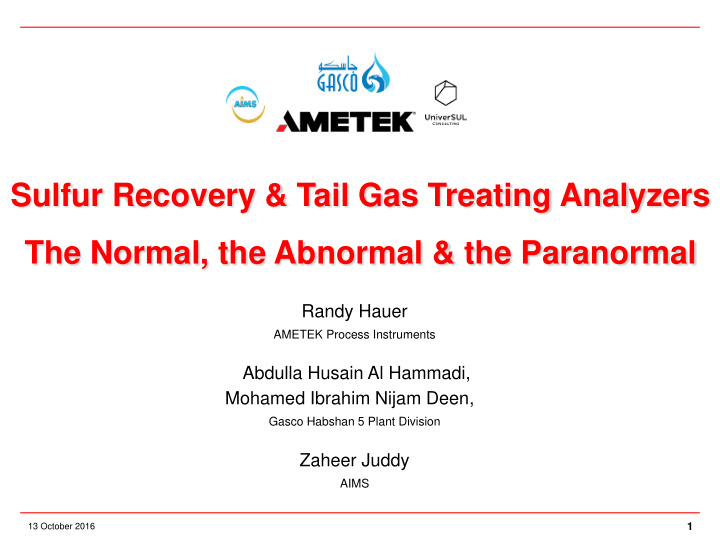



Sulfur Recovery & Tail Gas Treating Analyzers The Normal, the Abnormal & the Paranormal Randy Hauer AMETEK Process Instruments Abdulla Husain Al Hammadi, Mohamed Ibrahim Nijam Deen, Gasco Habshan 5 Plant Division Zaheer Juddy AIMS 1 13 October 2016
Analyzer Tags in the SRU/TGTU Process 2 13 October 2016
Part 1 / BTEX Analysis for Control of Co-firing BTEX (benzene, toluene, ethylbenzene, xylene) - >700 ppm in the amine acid gas (AAG) - >50 ppm leaving the reaction furnace - Results “carsul” formation and severe deactivation of catalyst Co-firing of natural gas to maintain reaction furnace temperatures > 1,050-1,080 C destructs the BTEX - Practical but has a considerable operating cost if continual BTEX values in the AAG >700 ppm are mostly short lived - Background values vary according to process conditions Xylene is the worst contributor to catalyst deactivation
Capability of an On-Line Full Spectrum Analyzer IPS-4 Full Spectrum analyzer - Developed for Superclaus “ABC + feed forward control - Combination of UV & IR • IR for total hydrocarbon for feed forward control • UV to speciate the BTEX Heated Acid Gas (HAG) Probe - Provide for it at FEED phase - Install at EPC phase, savings is huge - Future analyzer is the simple part
Design Case Gasco Habshan 5 Plant FEED had nominal 0.1% (1,000 ppm) BTEX in base case - On-line analysis was not provided for - Soot and carsul deposits on the catalyst were evident - Minimum reaction furnace temp of 1,050 was established utilizing co-firing of natural gas After initial quantification of the cost of co-firing an on-line BTEX / total HC analyzer was considered important enough to implement immediately Gasco, AIMS & Ametek worked closely and quickly to install the analyzer
Fourteen Day Trend of BTEX 800 ppm 600 ppm 400 ppm 6 13 October 2016
Transient BTEX Spike to 929 ppm on Aug 11 800 ppm 600 ppm 400 ppm 7 13 October 2016
Transient BTEX Spike (confirmed by lab) Jan 16 ACID GAS REPORT 800 ppm 600 ppm 400 ppm 8 13 October 2016
Trends for BTEX, Toluene, Xylene (H 2 S, CO 2 , THC) 800 ppm 600 ppm 400 ppm A Green: BTEX B Blue: Toluene C Yellow: Xylene D Purple: H2S E Red: CO2 F White: HC 9 13 October 2016
Summary & Conclusions On-Line BTEX Analyzer On-line analysis of BTEX for control of co-firing is practical - Close relationship & onsite support from vendor is essential Quantifiable Benefits - $1.75 million/yr fuel savings, 12 wk payback based on this alone - Increased catalyst life - Consequential CO 2 reduction of 120,000 tons/yr Front End Engineering Design must provide for the sample connection in a proper location fitted with the HAG probe If co-firing is standard operating practice, install an analyzer
Part 2 / The Normal, Abnormal & Paranormal On-line process analyzers are “trusted” when providing predictable results and called into question when not Tail gas analyzers exhibit a characteristic H 2 S/SO 2 signature any deviation is suspect and called into question Other on-line analytical data runs very static and near zero, any deviation from zero is suspect and called into question SO 2 breakthrough to the TGTU can be prevented, mitigated with a feed forward (total HC, H 2 S) analyzer Five case studies illustrating this……
SRU at Turndown (slow response vs plugging) 5:1 turndown N-Gas Assist 10:1 turndown N-Gas Assist Plugging
Tail Gas: Process Upset & Over-Range Event
COS & CS 2 in SRU Tail Gas (Refinery)
Field Data / HC Process Upset H 2 S swings from 83 to 87% THC = 0.25% 12 fold > in THC from 0.02 to 0.25% lasting ~3 minutes THC =0.02%
Effect of SO 2 Excursions on TGTU H 2 350 5.0 4.5 SCOT H2S (ppm) AND SCOT CAT TEMP (°C) 300 H2 (%), SCOT COS (ppm), SRU SO2 (%) 4.0 3.5 250 3.0 200 2.5 2.0 150 1.5 100 1.0 0.5 50 0.0 0 -0.5 0:00 0:00 0:00 0:00 0:00 0:00 SCOT H2S ppm SCOT OUTLET °C SCOT EXCESS H2% SCOT COS ppm SRU SO2 %
TGTU (COS & H 2 S) Steady State & Upset COS H 2 S H 2 S COS
Summary & Conclusions – Abnormal Results It is very rare for an analyzer to give a “false positive” result - In particular H 2 S/SO 2 in tail gas, when it is moving its working Train operators on the chemistry & physics of SRU-TGTU - There is generally a sound explanation, resolve it, build confidence Instrument data sheets analyzer at the FEED stage - Do not specify a range 2 orders of magnitude between the primary and secondary functions of a multicomponent analyzer - Consider the upset condition. Do not just set the full scale range at some random multiple of the normal value - Consult with the vendor, have a staff process analyzer specialist Consider the utility of a feed gas analyzer to prevent SO 2 breakthrough to the TGTU
Recommend
More recommend